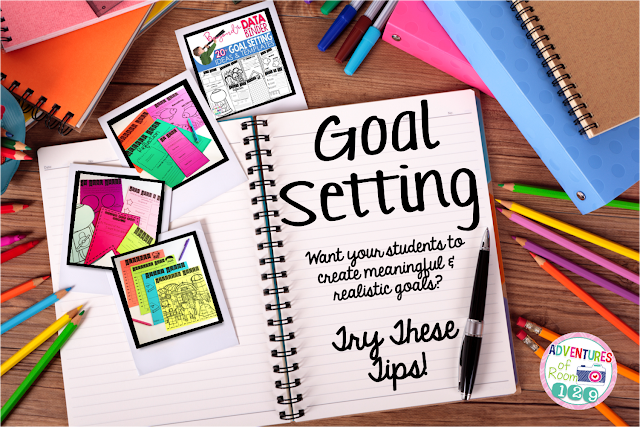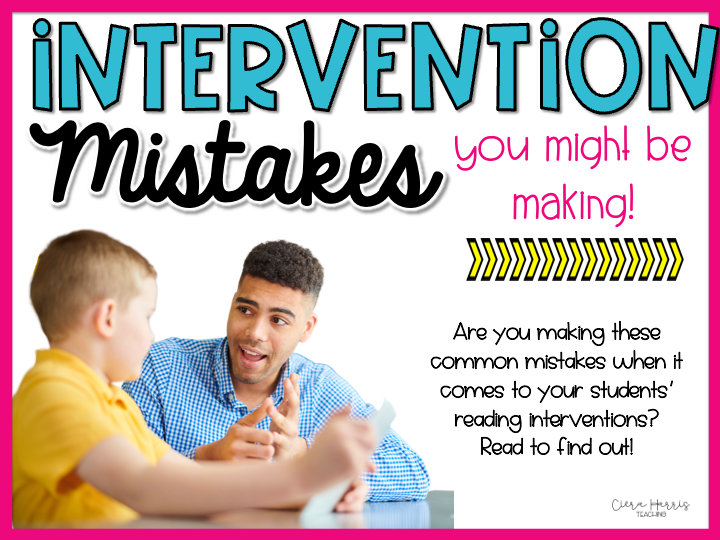So as teachers, we have lots on our plates at all times. Differentiating lessons, grading, planning, the list could go on and on! When we are in the middle of teaching a lesson we don’t just teach, we manage behaviors, inspire students, reflect and make split second decisions. All in all, we have a lot going on in our brains each and every day. But what if you could put a BIT of that responsibility into the students’ hands? What if for once, students could take charge of their data, their learning, and make decisions for themselves? Sounds amazing, right? Well, they can! Getting your students to analyze data and set goals is a valuable and much needed piece of your instruction. So let’s talk goal setting: How can you get students to goal set? How can I manage goal setting on top of everything else I have on my plate? How can I fit one more thing into my already packed schedule?
Want to watch the video instead? Check it out below! Make sure to subscribe to get updates on all new content!
I’ve compiled 10 ‘tips’ to help get you ready to goal set with your students. Hopefully with these tips and your amazing motivation, you’ll be able to give learning and power back to your students! Let’s do it!
#1: Model!
When you begin teaching a new concept and even a concept you’ve already exposed the students to, do you just expect them to understand what to do and how to think through solving the problems? No! Of course not. You model your thinking for them. You explain, take time to demonstrate what’s happening in your brain to work through the problem, you ask yourself questions and self reflect to make decisions. Having your students goal set is no different than teaching! The same process is needed. Model for the students HOW to set goals. Set up some of your own goals and model going through the thinking and reflecting process for them so they understand and can see what it’s like. The more exposure to seeing it being done, the stronger understanding they’ll have and the more concrete and realistic goals they will set!
#2: Goal Set Daily!
Yes, I said it – daily! Stop thinking that setting goals has to be a BIG ordeal. It doesn’t. You can have students set goals in (almost) every lesson you teach without having to do a SINGLE bit of planning. So you’re doing a math page from your workbook? Have the students set a goal on how many problems they think they can get done in ___ minutes that you’re giving them to work. Are you reading passages in Science or Social Studies? See if they can set a goal on how many new words they can identify as they read – then together as a class you can work on defining the words to better understand the passages. Are you practicing subtraction with regrouping for the thousandth time? Write 3 reminders on the board and have the students make a goal of focusing ONE of those reminders that they will remember to do when practicing. Find SOMETHING each day to set a goal. Maybe it’s a behavior goal you set at the beginning of the day? Goal setting daily will show students the power behind setting goals and it will help it become more of a habit than just something you do once a month!
#3: Celebrate!
What’s the point of setting a goal? To meet it! To accomplish whatever you have written down. So what do you do when you’ve accomplished the goal? You celebrate! It doesn’t matter if its a goal they have been working on for a month or a goal they set 20 minutes ago at the beginning of your lesson, you stop and celebrate! Get out GoNoodle and have a 60 second dance party. Stand up and take a bow. Write “You’re Amazing” on a few post it notes and hand them out. It doesn’t have to be a spectacular celebration, but acknowledging the students hard work and motivation will just make the next goal for everyone even more important and will make those who met their goal feel like a million bucks!
#4: Long Term Vs. Short Term
I bet when you started reading this, it was going to be all about setting these large and almost unrealistic goals? Nope. There has to be a balance. There’s a time and place for setting those larger goals of trying to reach a certain guided reading level or getting your multiplication math facts mastered. Those are definitely examples of long term goals. But to make goal setting real and meaningful, there has to be a balance between the long term and short term goals. Set daily goals, then set weekly goals on top of the monthly goals you set. Mix it up. Show the students that anything we do we can have a goal and a focus to help motivate and achieve! (Pictured below are some awesome examples of short term vs. long term goal setting ideas. Goal setting bookmarks are perfect for quick daily/weekly goal setting. Autograph walls and ‘Goal Fish” are fun for more long term goal setting! Check them out here!)
#5: Guiding Questions
I completely understand that, especially to my primary friends, goal setting is a very abstract concept. Students’ goals will be wild and crazy and you’re going to want to just make goals for your students. But I highly recommend that you don’t do that! So what can you do? Guide their thinking with the questions that you ask them. A good coach never does the hard work for the player, right? They guide the player by modeling, feedback, and reflection. This is what your students need. Guide their thinking by asking them questions? Ex: you have a student who wants to learn 50 sight words in a month. Doable? Maybe?! Realistic? Probably not. Guide them! “T: Suzy, I love that goal and that’s a lot of words! Do you know how many sight words are normally on our spelling list? S: No T: There are 5. So in one month we normally only learn around 20 new sight words. Do you think 50 sight words would be an easy goal to meet if we normally just learn 20? Let’s look at your spelling tests from this past month to see how you’re doing…” I think you get the picture from there! Guide them!
#6: Use Data!
If you read the last part of tip #5 you saw the conversation between the teacher and the student and how the teacher was about to pull out the students’ old spelling tests to help them set their goal. Using data to set goals can be extra powerful. Make sure the students understand the data you’re showing them before you expect them to make a goal based on it. Maybe you’re having them fill out their data binder goals for the new quarter. You want them to set a goal for their vocabulary tests that you give each week. Simply pass back or have written down the last 3 vocabulary test scores for the students to use to reflect on before making their decision and filling in their data binder goal with something that is unrealistic for them. (Need some new data binder inserts or just getting started on your data binders? These editable templates can help! Simply print them on colorful paper and your data binders will be bright, cheery, and motivating! Check them out here!)
#7: Realistic Vs. Unrealistic
Like I mentioned before, goal setting can be abstract. Have conversations with your students about what realistic and unrealistic goals look like and feel like. This doesn’t have to be done in a formal lesson. Any chance you can get to model setting an unrealistic goal is just as valuable as modeling a realistic goal. Students need to see, hear, and understand both sides of the spectrum to make their goal setting experience more valuable. Use the terminology of ‘realistic’ and ‘unrealistic’ with the students too. Don’t shy away from it. Students will catch on and understand what the words mean and lot quicker than you think!
#8: Use Visuals
This might not work for every goal you have students set, but any time you can have or post a visual reminder for students, the better! I often create banners or bulletin boards in my classroom that allow students to see not only their goals but everyone’s goals. Sometimes the names are on the back for privacy but not always! Having the visual is perfect to help motivate the students to meet their goal and also serve as reminders for everyone. Take time to acknowledge the space/visuals in the room too. Just a simple point and sentence of “Don’t forget about what we’re all working towards, boys & girls. I know you’ll all be very focused and working hard to meet your goals!” (Pictured below are some fun ideas for visuals! Banners to hang around the room, ‘Goal Balls’ like gum balls is a fun way to post students’ goals on a bulletin board. Check them out here!)
#9: Reflect
How do you know whether or not you’ve met a goal? You take the time to look at the data and compare it to the goal to see whether or not the goal was met. Does it stop here? Nope! Students need to reflect on why they did or did not meet their goals. What steps did they take or possibly forget to take that gave them the results they got? How was their effort towards their goal? What factors did they have control of that affected the goal too? Again, students won’t be able to do this step naturally. It will need to be modeled for them and will take time before students are able to do it naturally, but it’s a much needed piece of the goal setting process!
#10: Use Action Steps
Sometimes setting the goal is the easy part, but how to reach the goal is harder. Action steps can be an easy way to get students to understand the work that is needed behind meeting the goal that they’ve set. Action Steps are basically a type of ‘to do’ list that will potentially lead to meeting the goal. An example would be: Student set a goal of getting to level K in guided reading. Clearly a long term goal. So on their goal sheet they wrote out their action steps: #1. Meet with teacher at least 3 times a week to practice. #2. Read every night and fill in reading log to turn in. #3. Focus on sight words on spelling list. Again, I think you get the picture. Having action steps help make it clear for the students about WHAT they are supposed to be doing and can also help bring in parents into the goal setting process!
Whew! I HOPE that through these tips you are now feeling motivated to go out and get some goals set with your little ones. Whether they are in PreK or 12th grade, goal setting is an important part of their educational journey. Put the learning into THEIR hands! Make them the ones responsible for their journey. Motivate them, guide them, give them the tools and see what MAGIC truly happens!








